ITALY
2008
Day 5
Sunday, May 11th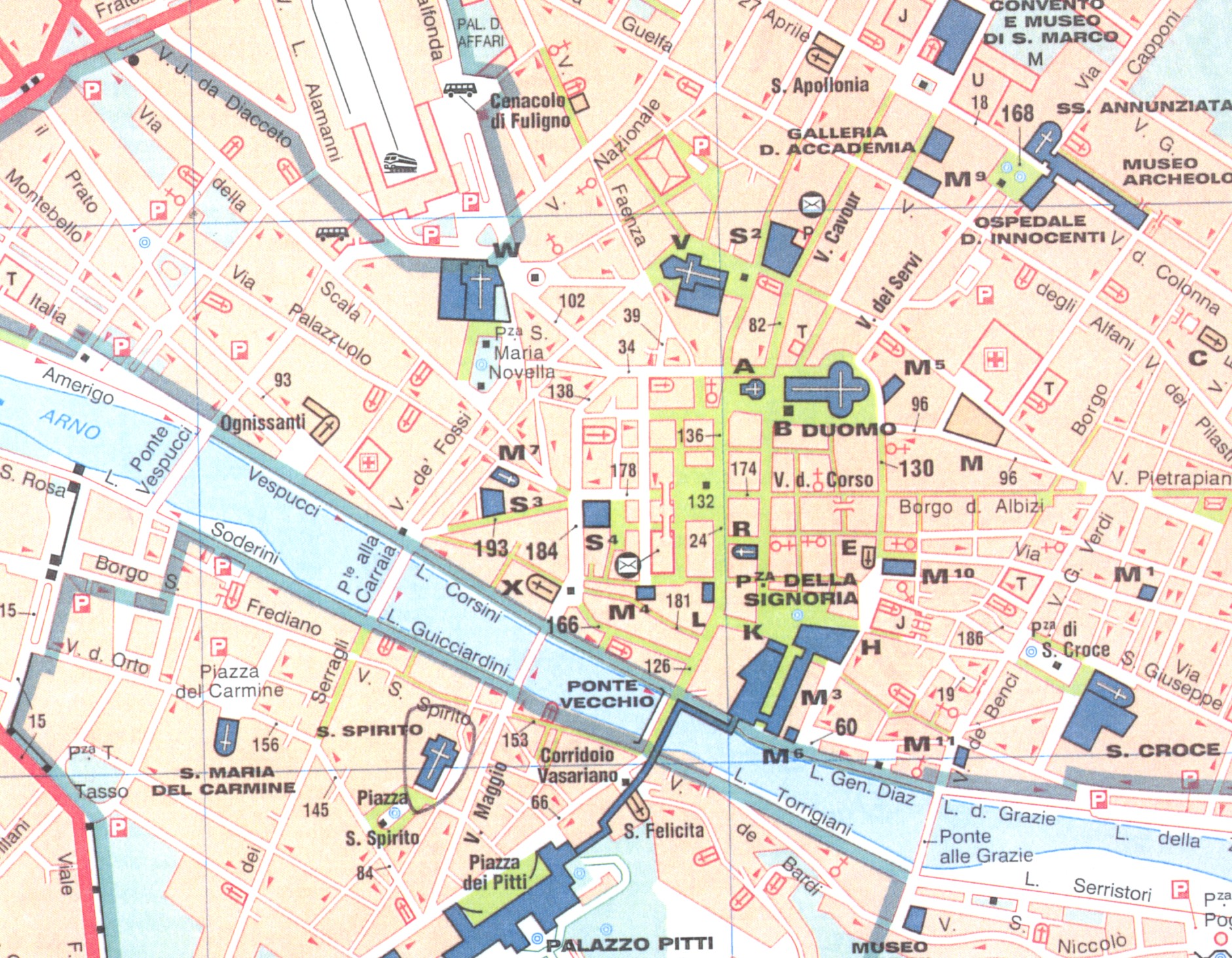
FLORENCE
We slept until 7:30. We
hadn’t had a chance to buy any groceries so we drove into Fiesole. The
road was unbelievable. We
just held our breath when a car approached. The
views were spectacular. There
was the only way into Fiesole.
Fiesole
was a charming little town about five miles north of Florence and has
a n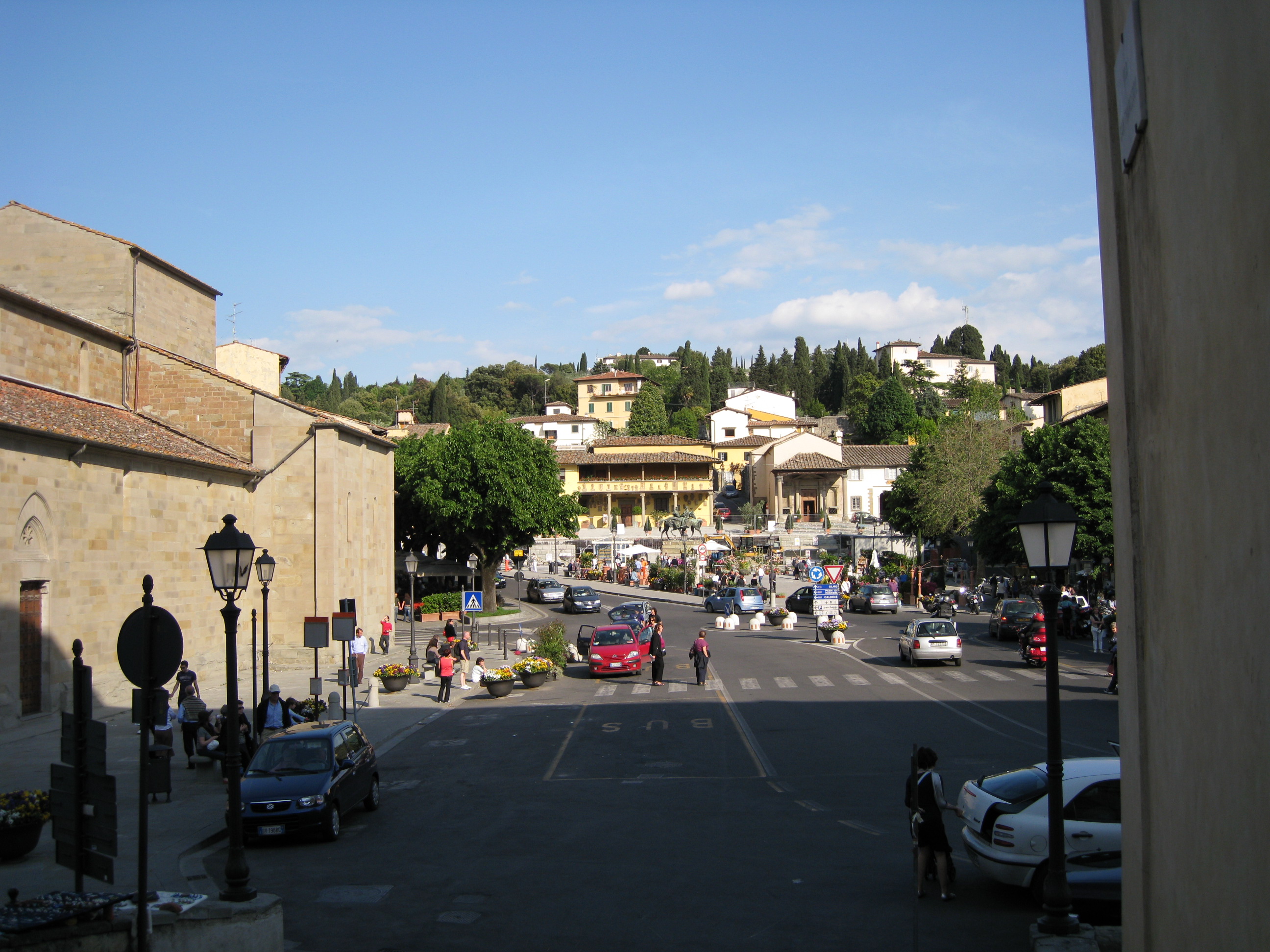 umber of substantial Roman and Etruscan remains. Settled
in the 7th century BC, Fiesole was a powerful force in central Italy
by the the 5th century BC. It began to decline after the Romans
founded Florence in the lst century BC, but kept its independence
until 1125, when Florentine troops razed most of the city.
Eyewitness Travel guides on Florence and Tuscany suggests a two hour
walk through Fiesole. Unfortunately we never did take the
tour. We found a
parking place on the street and stopped at a café for breakfast –
coffee and pastries. From
Fiesole there is a magnificent view of Florence and particularly the
Duomo (cathedral). The bus stop was located across from the café in
the Piazza Mino da Fiesole. We
caught the bus to Florence but we didn’t know how to pay. There
was a toll box in which you inserted your ticket, but not everyone put
their ticket in slot, so we had a free ride. It
was only a 15 minute ride. We got off the bus at the Duomo. umber of substantial Roman and Etruscan remains. Settled
in the 7th century BC, Fiesole was a powerful force in central Italy
by the the 5th century BC. It began to decline after the Romans
founded Florence in the lst century BC, but kept its independence
until 1125, when Florentine troops razed most of the city.
Eyewitness Travel guides on Florence and Tuscany suggests a two hour
walk through Fiesole. Unfortunately we never did take the
tour. We found a
parking place on the street and stopped at a café for breakfast –
coffee and pastries. From
Fiesole there is a magnificent view of Florence and particularly the
Duomo (cathedral). The bus stop was located across from the café in
the Piazza Mino da Fiesole. We
caught the bus to Florence but we didn’t know how to pay. There
was a toll box in which you inserted your ticket, but not everyone put
their ticket in slot, so we had a free ride. It
was only a 15 minute ride. We got off the bus at the Duomo.
Our first visit to Florence was on
our Globus Italian Tour in 2004. Although
we spent three nights in Florence, we had only one day to see the
sites. The
second day we visited several other towns in Tuscany. So
now we have a week to enjoy this wonderful city plus several
surrounding towns.
Florence, the seat of the beginning
of the Italian Renaissance, is a town rich in history, architecture
and art. There
are thousands of books and hundreds of websites devoted to every
aspect of this magnificent city. I
could not add anything original to what has already been written so I
will not discuss the history of Florence; however, I will comment on
the highlights of the churches that we will visit. A
great resource that I would like to recommend is The Teaching Company
course on The Italian Renaissance by Professor Kenneth Bartlett. In
addition to individual
books on various Florence churches, I have
enjoyed studying two art and architecture books – Florence
Art and Architecture published
by Tandem Verlag GmbH and Art
and Architecture Florence by
R.C. Wirtz. The
first book is a large, coffee table size with over 500 pages of full
page Florentine artwork. The
second book is a treasure filled guide to Florence. It
measure about 6” X 6” with 560 pages of maps, pictures, and
information about everything in Florence. It
is small enough to carry with you. This
book was very helpful in dividing up Florence into areas so that each
day we were able to take a different section of Florence and explore
all the churches in that area before going to another part of town. We
had made notes on what we wanted to see each day of our visit. A tour
book that is also very informative is Eyewitness Travel Guides –Florence
and Tuscany. It
has great maps, pictures and descriptions.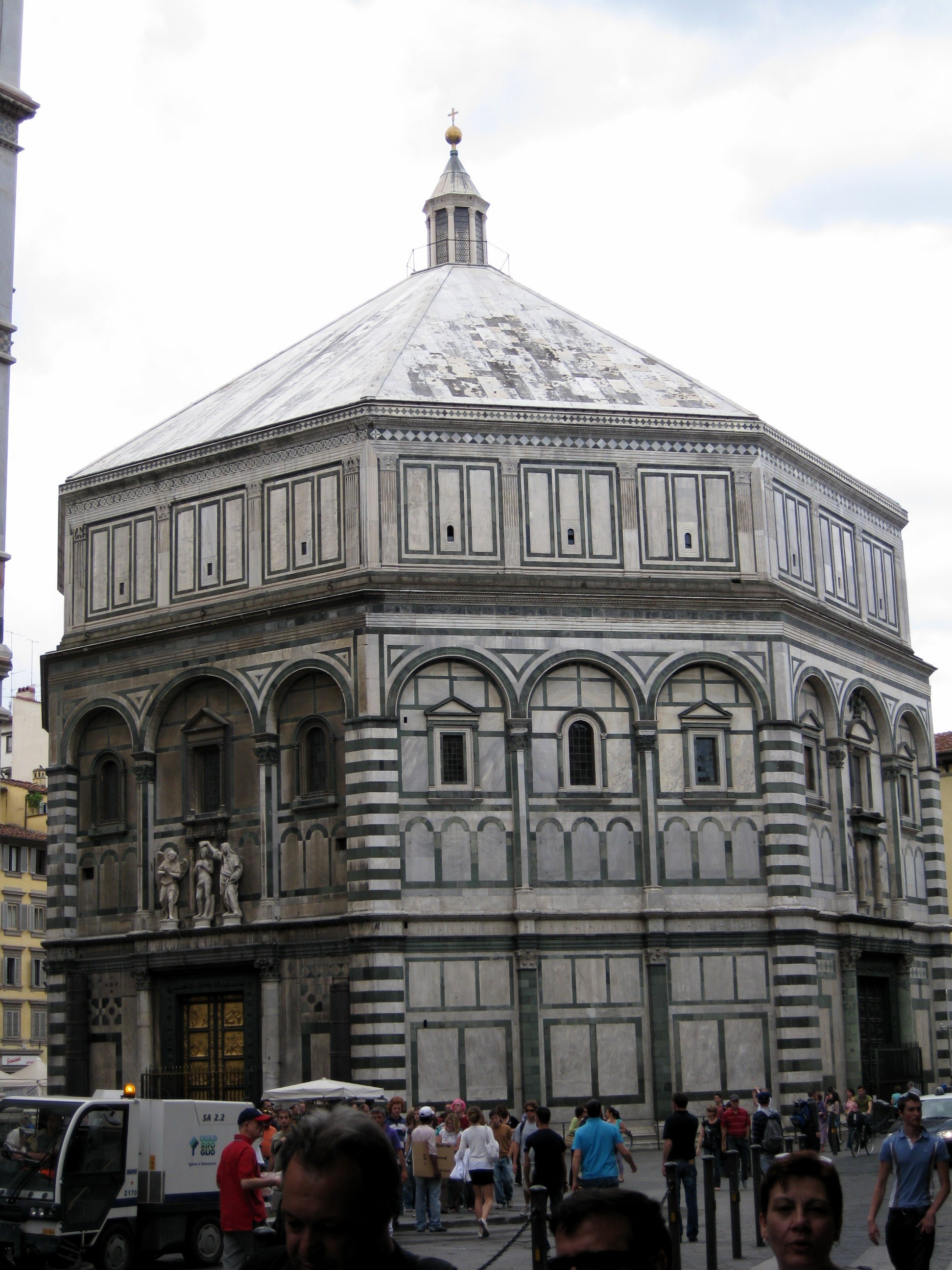
Our
first stop was THE
BAPTISTERY, located across from the Duomo. It
was open so we went in – it had not been open on our first visit.
The Baptistery is an octagon shaped building. The Baptistery
with its famous doors is one of Florence’s oldest buildings. Tradition
is that it was built on the site of a temple to Mars, dating to the 5th century.
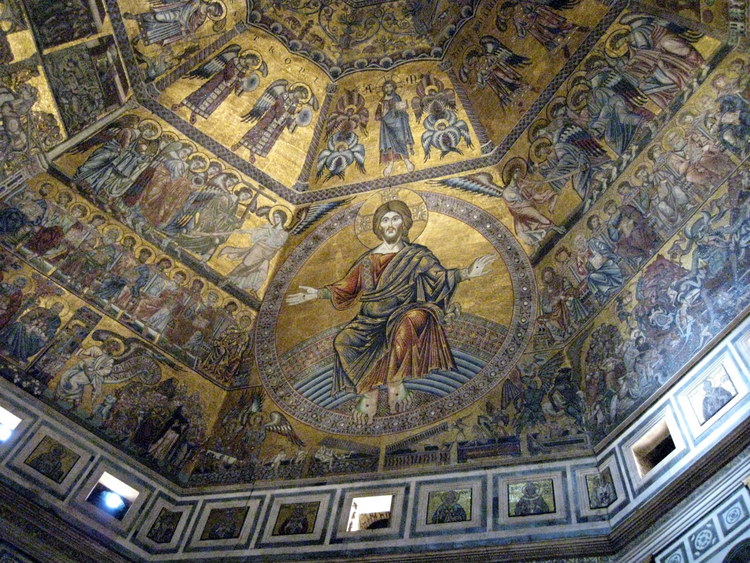
The ceiling contains a 13th century
mosaics illustrating the Last Judgment. It
was a beautiful building. I
took a lot of pictures as photos were allowed.
The three sets of doors are
spectacular. 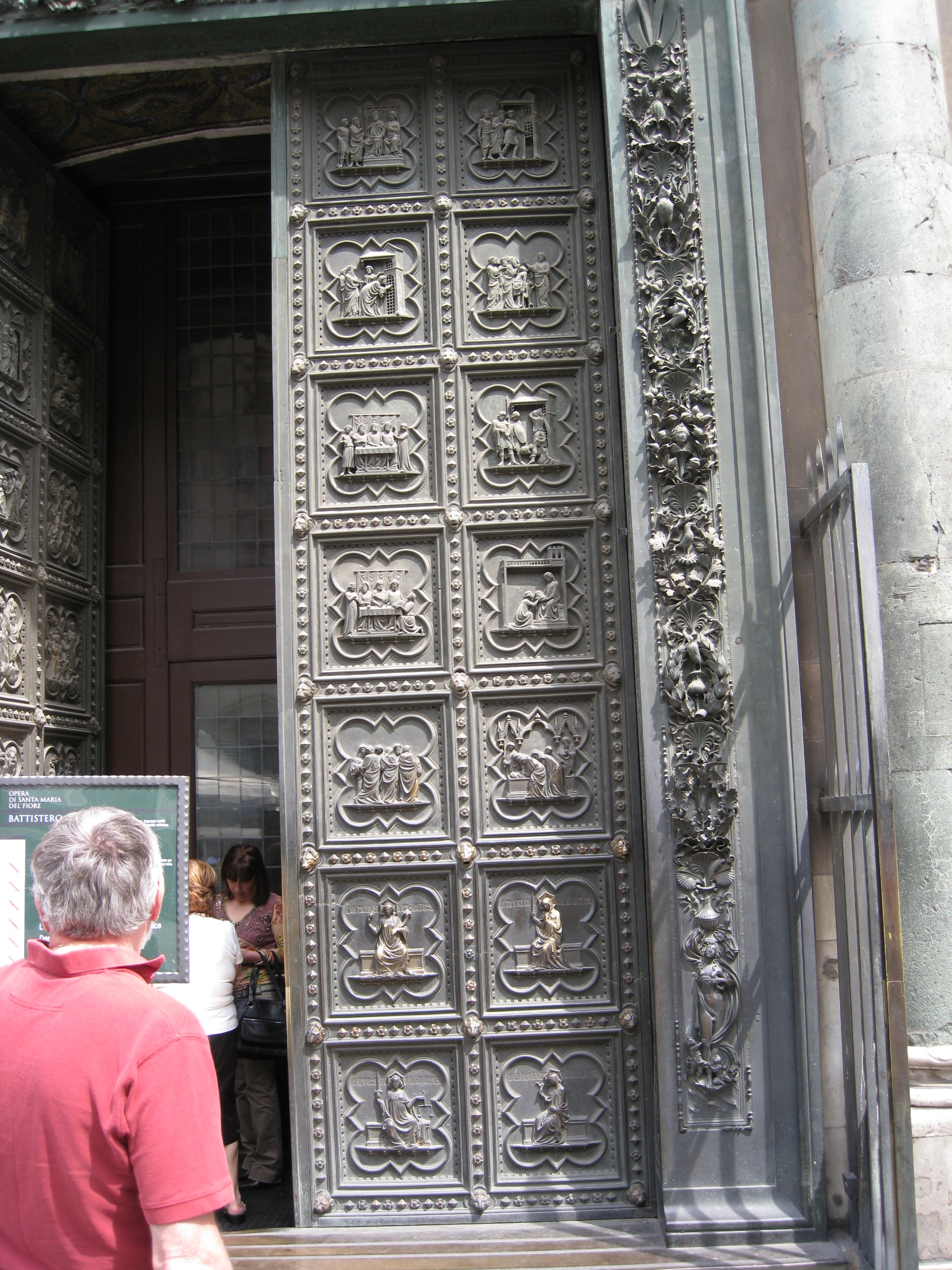
The south doors, with 28 panels, were
designed by Andrea Pisano and cast in bronze - 1330-36. The
twenty upper squares depict events from the life of John the Baptist. The
lower eight show representations of Christian and worldly virtues.
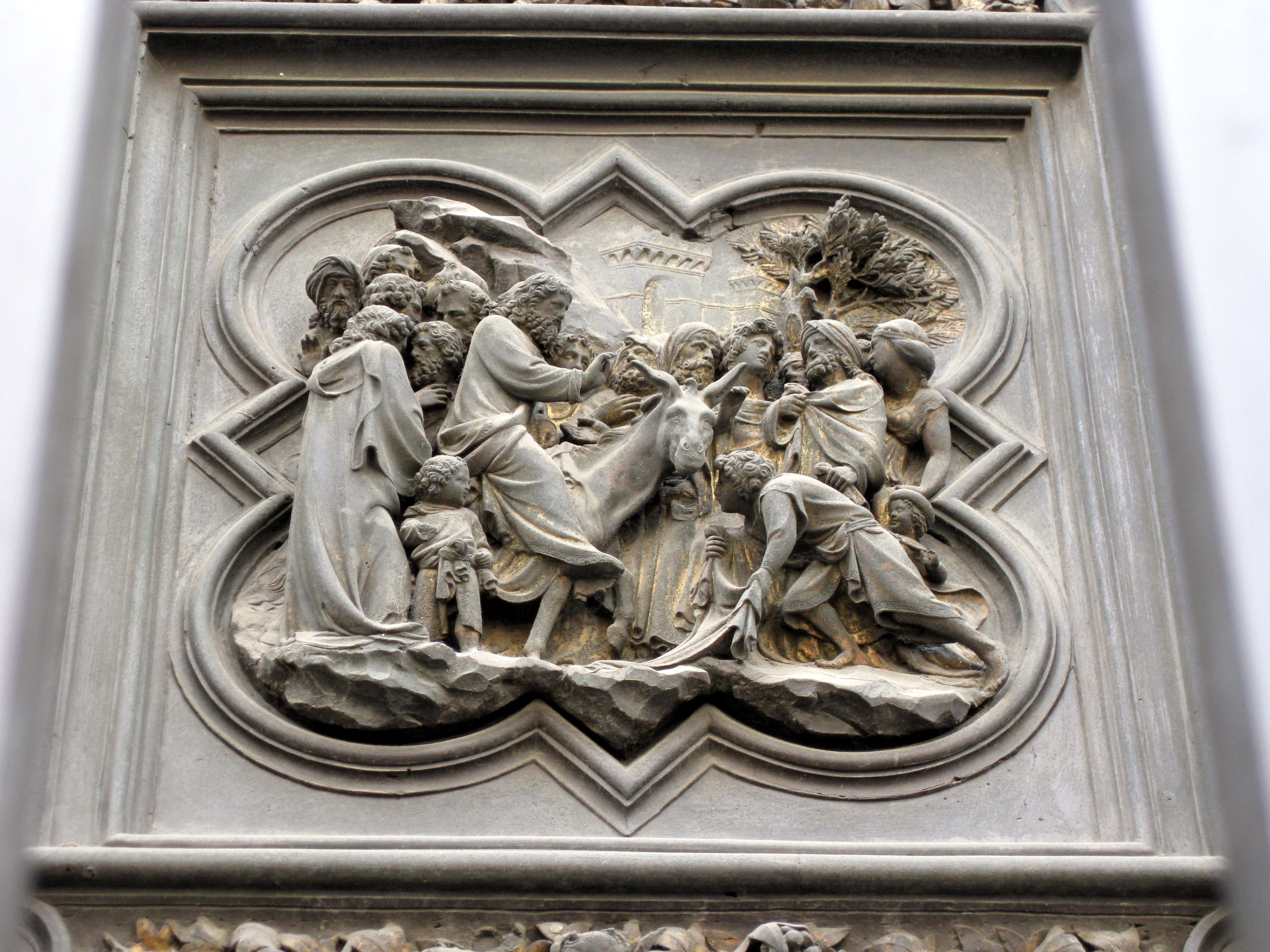
The north doors are the result of a
competition held in 1401 which was won by the 23 year old Lorenzo
Ghiberti. Like
Pisano’s south doors, the north doors contain 28 squares. The
top twenty are scenes from the life of Jesus. The
bottom eight portray the four evangelists
- Matthew, Mark, Luke and John, and four church fathers -
Ambrose, Jerome, Gregory and Augustine.
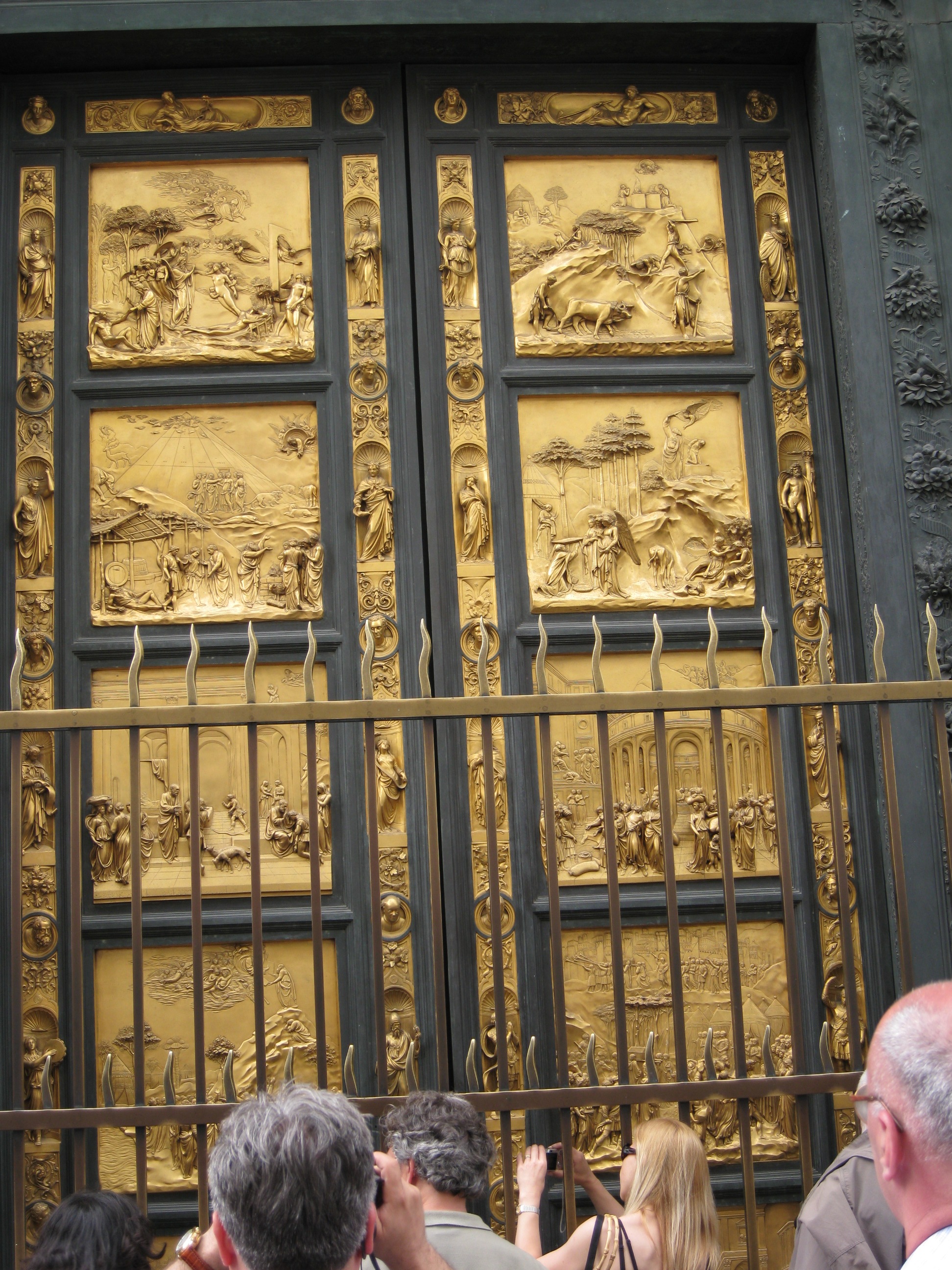 The
east doors – facing the Duomo- are called The Gates of Paradise. These
doors were done by Lorenzo Ghiberti who spent 27 years working on
these doors. He
began them in 1425. Giorgio
Vasari described these doors as the most complete and beautiful work
of art to be found on the earth. Instead
of 28 panels as in the other two sets of doors, these
doors contain only ten square reliefs which represent - Paradise,
Noah, Jacob and Esau, Moses, David, Cain and Abel, Abraham and Isaac,
Joseph, Joshua, and King Solomon and the queen of Sheba. These
highly polish relief panels are reproductions as the originals were
place in the Duomo museum several years ago to protect them from the
weather. The
east doors – facing the Duomo- are called The Gates of Paradise. These
doors were done by Lorenzo Ghiberti who spent 27 years working on
these doors. He
began them in 1425. Giorgio
Vasari described these doors as the most complete and beautiful work
of art to be found on the earth. Instead
of 28 panels as in the other two sets of doors, these
doors contain only ten square reliefs which represent - Paradise,
Noah, Jacob and Esau, Moses, David, Cain and Abel, Abraham and Isaac,
Joseph, Joshua, and King Solomon and the queen of Sheba. These
highly polish relief panels are reproductions as the originals were
place in the Duomo museum several years ago to protect them from the
weather.
Again the information that I carried
in my travel notebook, was a sheet showing the three doors with the
names of the panels. I
took a picture of every panel and wrote the number of the photo in the
proper panel on my paper. This
preparation made it easy to identify the panels when looking at them
and later in identifying the photos.
Our plan from the beginning of the
“cathedral quest” was to attend the Sunday service at the Duomo. We
especially wanted to do this because that Sunday was the Feast of
Pentecost, and we knew it would be a very festive service. Last
year we were in Trier on Pentecost and attended a very festive service
at the ancient cathedral plus a Bach Mass in a Baroque Church – St.
Paulin - later in the afternoon.
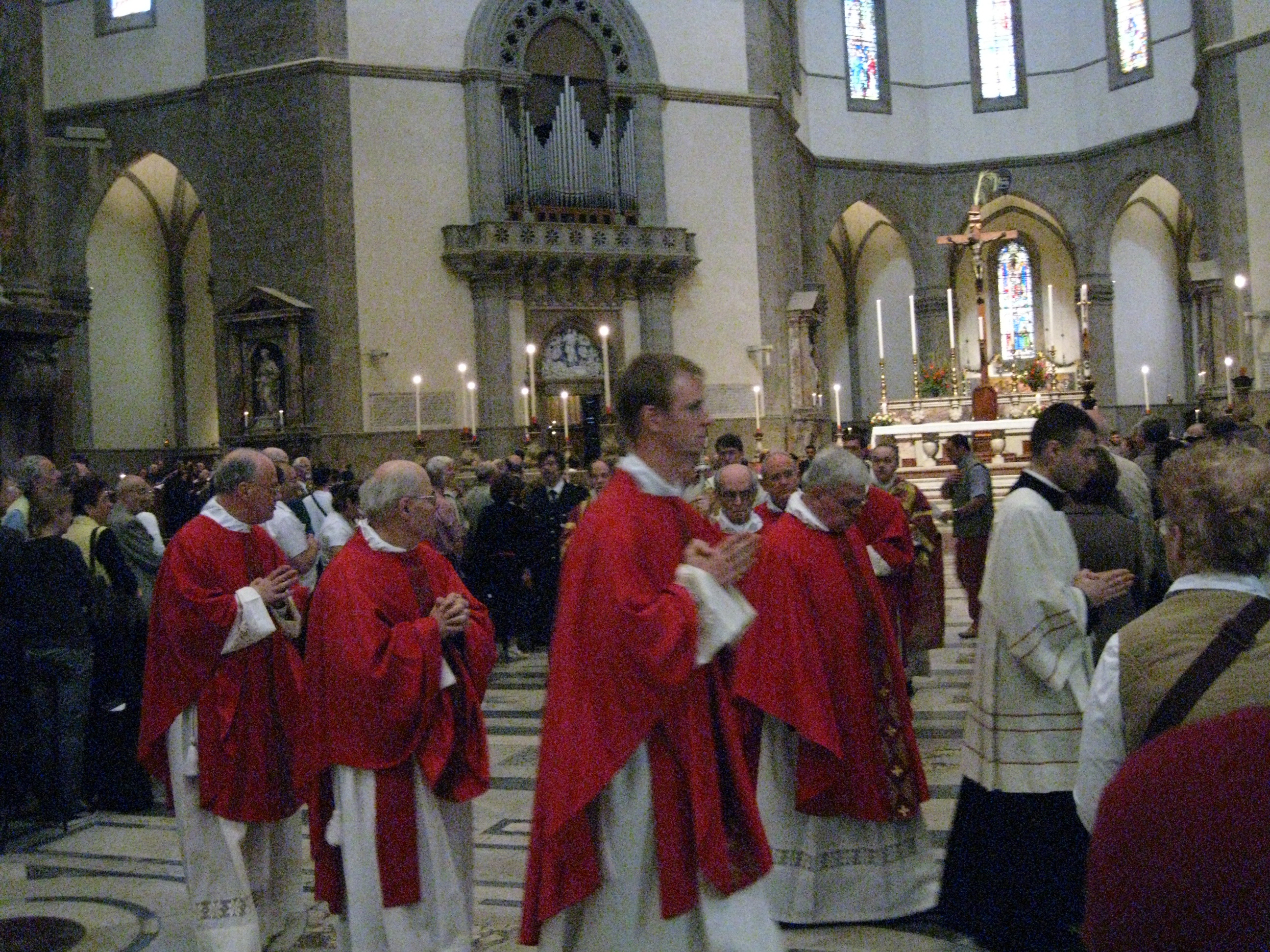
We had chosen to attend the noon day
Pentecost service at the DUOMO as
the information said that it was with organ and the earlier service
was choral. What
we didn’t know was that the 10:30 was the major service complete with
organ and choir, and the Bishop and clergy all vested in red. We were
able to enter the church to attend the last few minutes of the 10:30
service. After
the congregation left, we were able to move up front, right under the
dome. This
service was rather plain with only one priest and an assistant.
We were able to follow along with the Italian. The
lessons for Pentecost were printed in several languages including
English. It was the same readings as back home. After
the service I was able to take a number of pictures under the dome
because we had been sitting there. When
we went back later, that area was blocked as well about half way down
the aisle. We were glad to have been there for the
service and been able to see the dome and take pictures. Even
though we had been on a guided tour on our visit to the Duomo in 2004,
our visit had been quite short as there were many sites to visit in
one day. It
was nice to be able to walk in and out of the Duomo at will and visit
it several times during our week in Florence.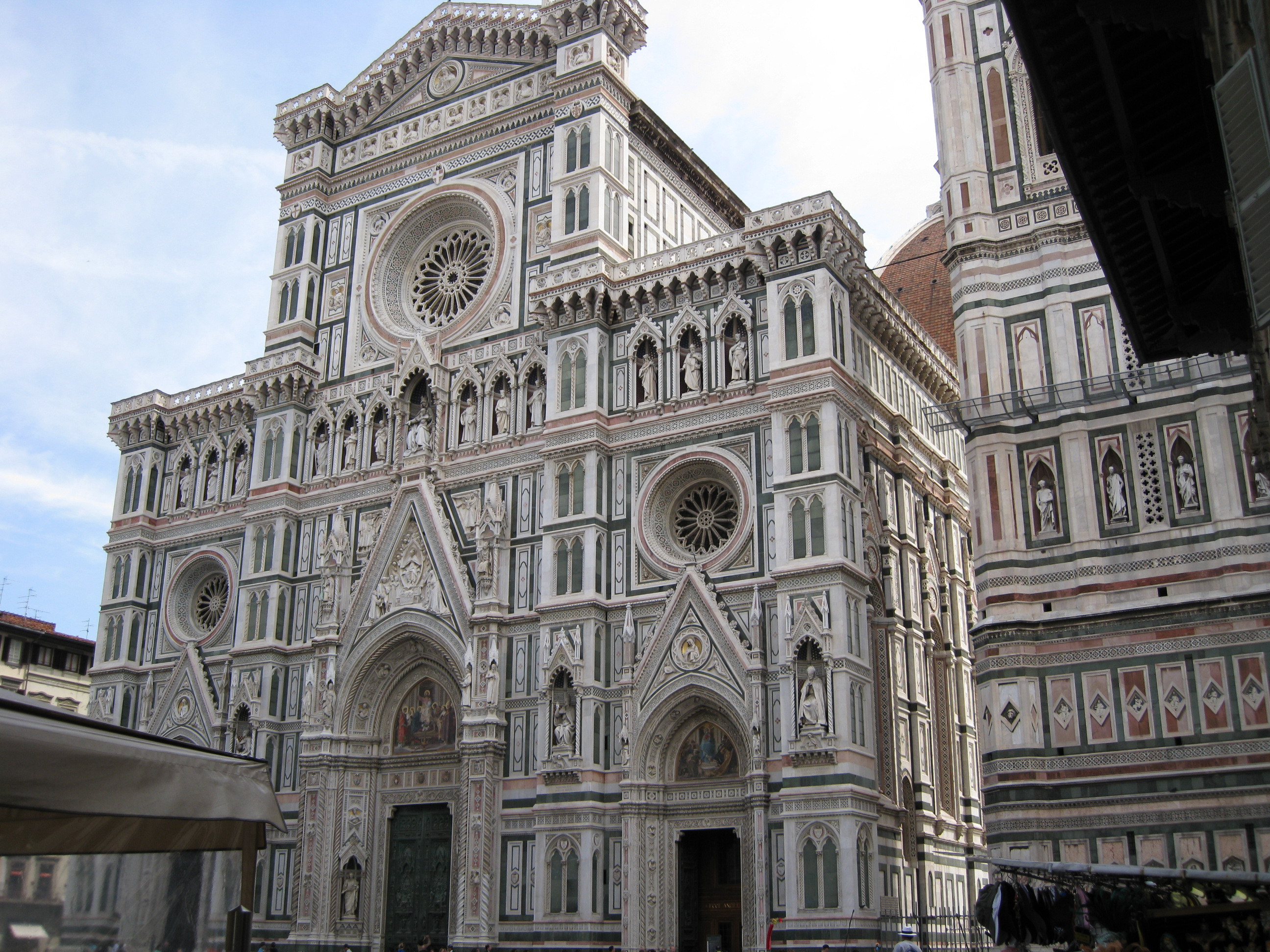
The Duomo – Duomo Santa Maria del
Fiore – is one of the world’s largest Christian church and one of the
most recognized because of its very large and distinctive dome. Work
on this building was begun 1296 under its first architect Arnolfo di
Gambio on the site of an earlier and much smaller basilica.
Gambio died in 1302 with only one story of the façade and a
few bays of side aisle wall completed. Various
architects continued the building, each making sufficient changes. Finally
in 1368, 72 years after its beginning, a specially appointed
commission agreed on a model of the church which that would be used
until its completion.
It was not until 1871 that agreement
was reach on the construction of the neo-Gothic redesign of the
façade. An
older unfinished façade was demolished in 1588.
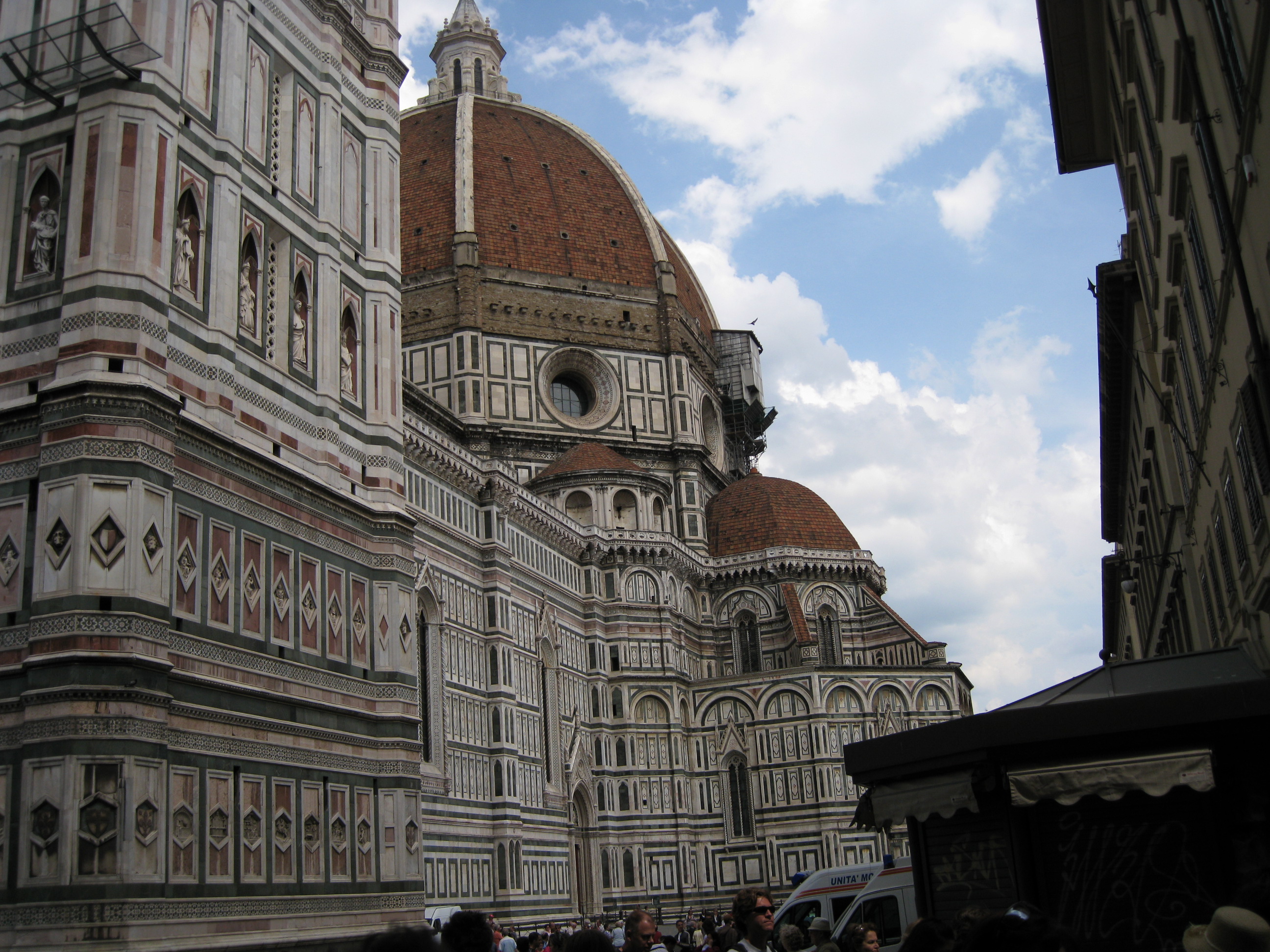 The
Famous dome can be seen all over Florence. The size and shape of the
dome to be built over the crossing was determined by the model of
1368. The
serious technical problems posed by the enormous dimensions remained
unsolved for several centuries. The
Famous dome can be seen all over Florence. The size and shape of the
dome to be built over the crossing was determined by the model of
1368. The
serious technical problems posed by the enormous dimensions remained
unsolved for several centuries. 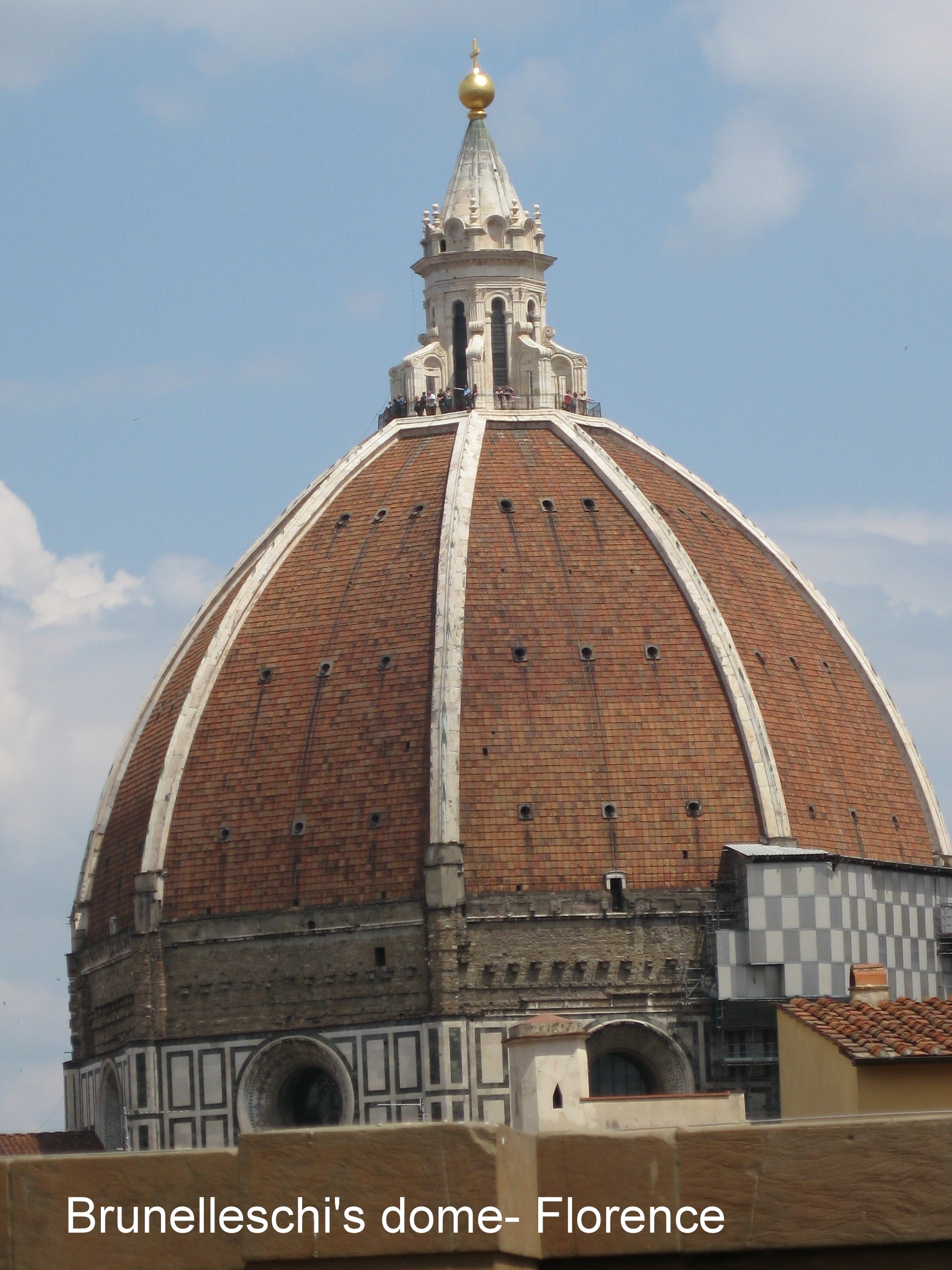
The base of the dome was 148 feet and
was almost 330 feet high. As
a result of suggestions and competition by a number of builders,
Filippo Brunelleschi won the commission in 1418 and completed the dome
in 1436. To
understand the problems and marvel of building this dome, I would
recommend reading Ross King’s fascinating book, Brunelleschi’s
Dome.
It is possible to climb the 463 steps
to the top of the dome and view Florence from the top platform. Sorry,
but I didn’t think that I could do that, so I didn’t even try.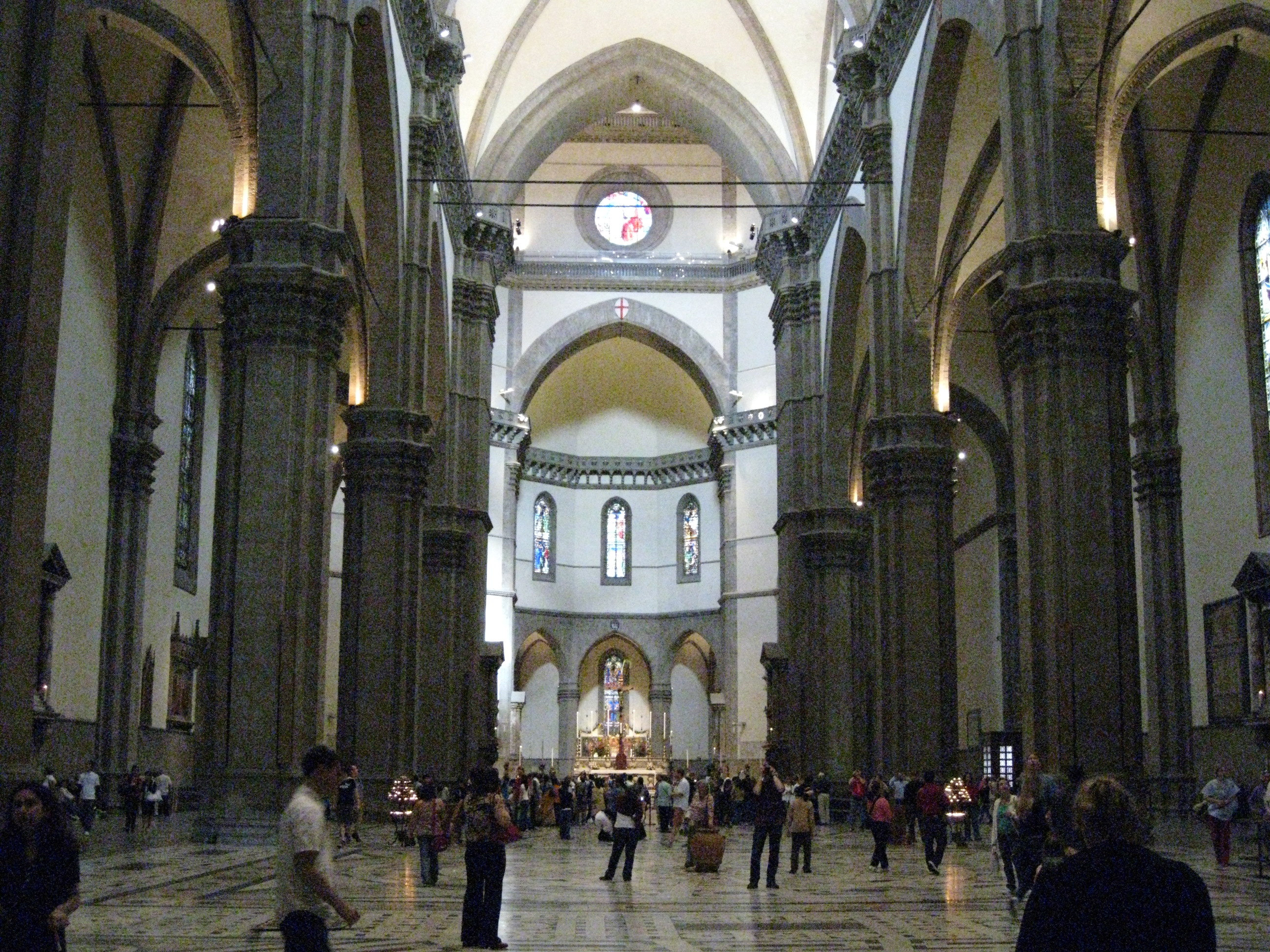
The inside of the Duomo is
constructed with three aisles on a Latin cross plan. Much
of the lavish interior decorations have been removed over the
centuries. Some
of these are preserved in the Duomo museum located behind the church. The
building is over 500 feet long with a height of 75 feet.
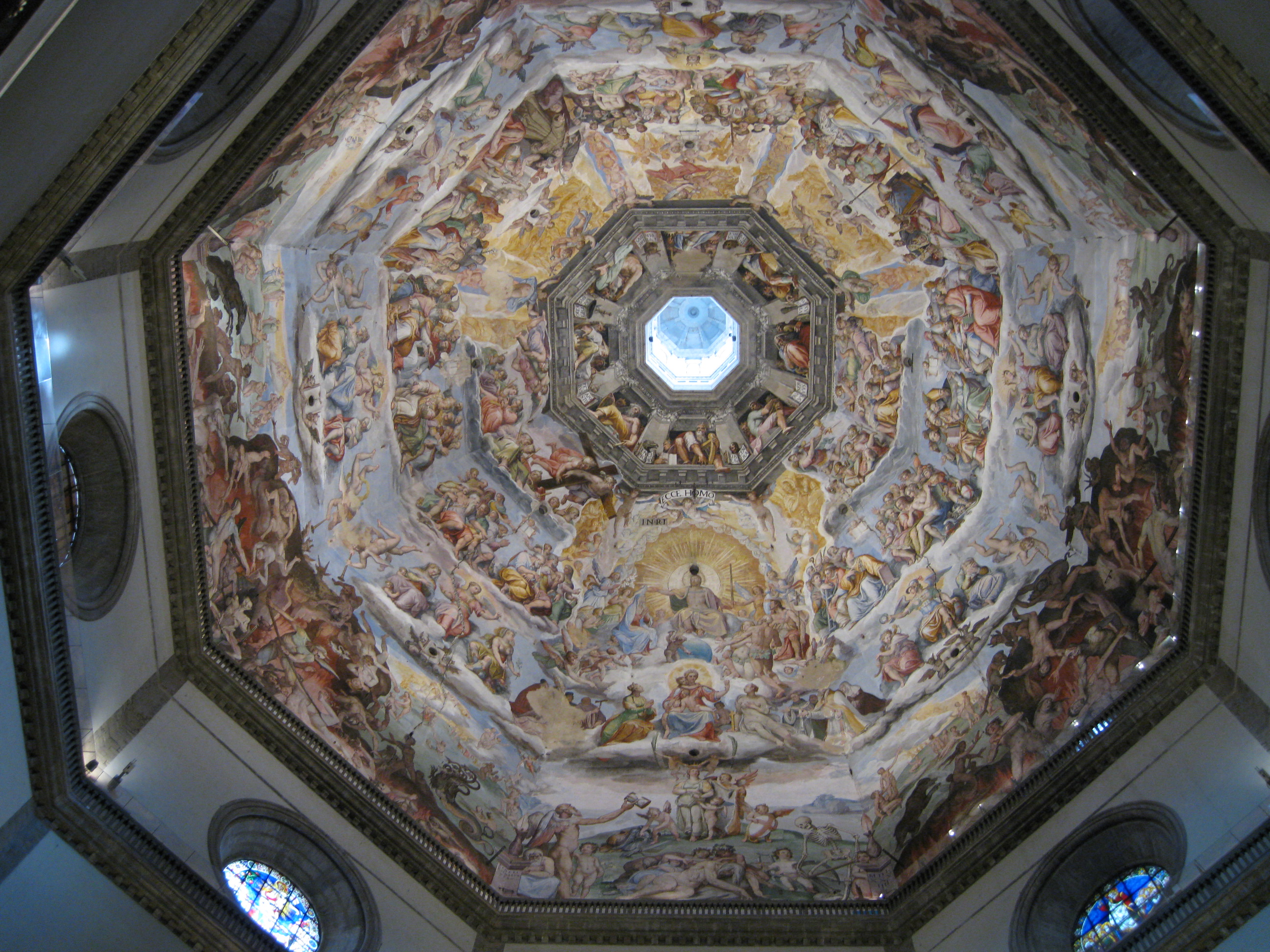
The interior of the
dome is a fresco of the Last Judgment by Giorgio Varasri which was
begun in 1572. Normally
the area under the dome is blocked off, but
we were fortune to sit under the dome for the service and were able to
stick around a while to admire it and to photograph each section.
The interior walls have a minimum of
stained glass windows. There
are several painting on the walls including the famous painting of
Dane and the Divine Comedy.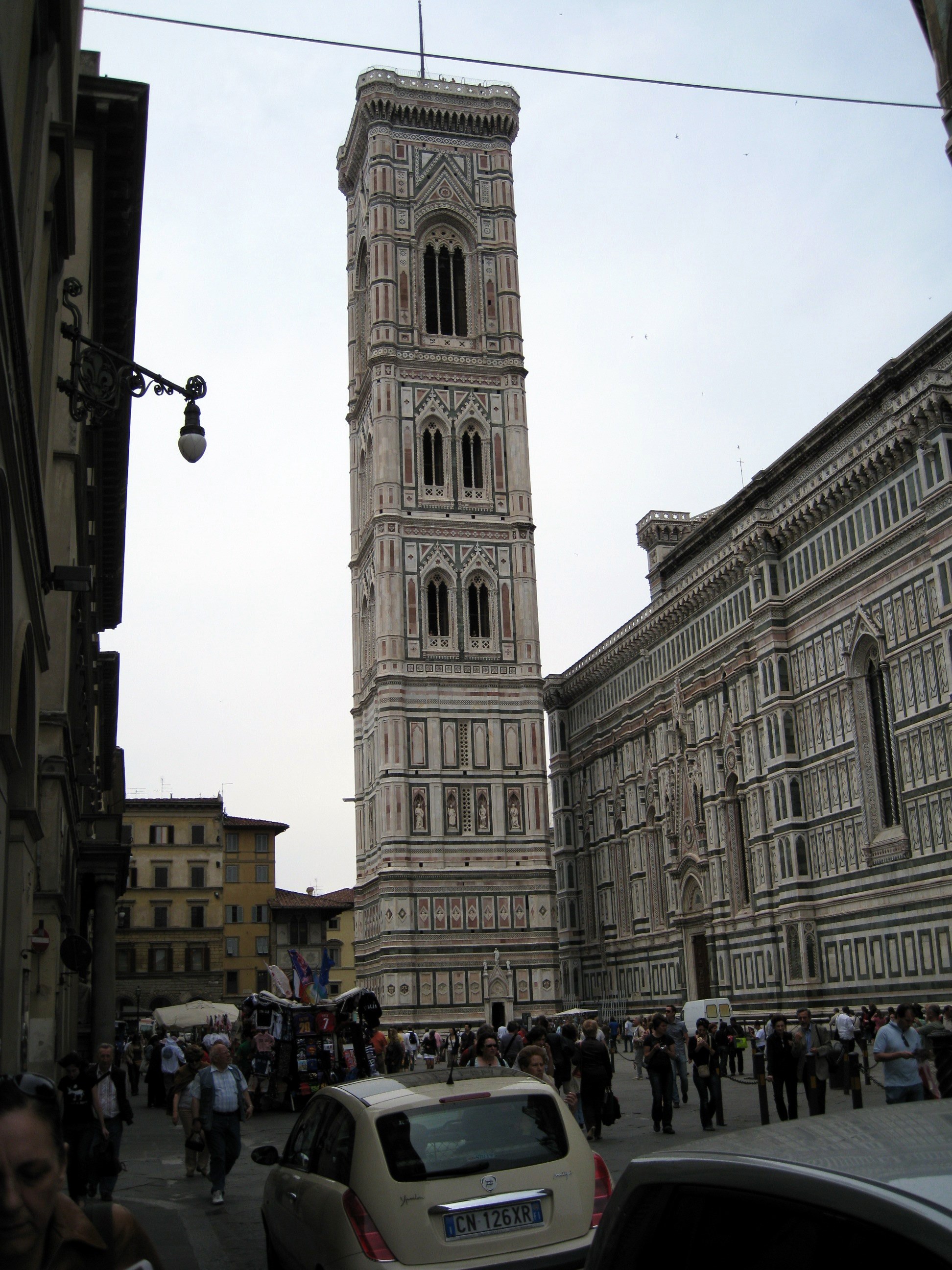
Before leaving the Duomo for now, I
must mention the Bell Tower – in Italian called the Campanile. The
building of it was supervised by three successive architects. It
was designed by Giotto and was begun in 1334. It
was completed in 1359, twenty two years after Giotto’s death. The
height of the Campanile is 278. It is also possible to climb the 416
steps to the top. Again,
I didn’t try it.
After church we walked around the
back of the Duomo to take pictures. We
went to the Duomo museum but they were closing. By
this time we were getting hungry so we found a nice café behind the
Duomo. The wind had started to blow, and it turned cool so we decided
to eat inside. My
wife had carbonerra, and I had the special which was pasta with
mushrooms, cheese and olives plus four slices of thin pork and small
roasted potatoes. After
lunch we walk around Duomo.
Walking down the street to the south
of the Duomo, we came to CHU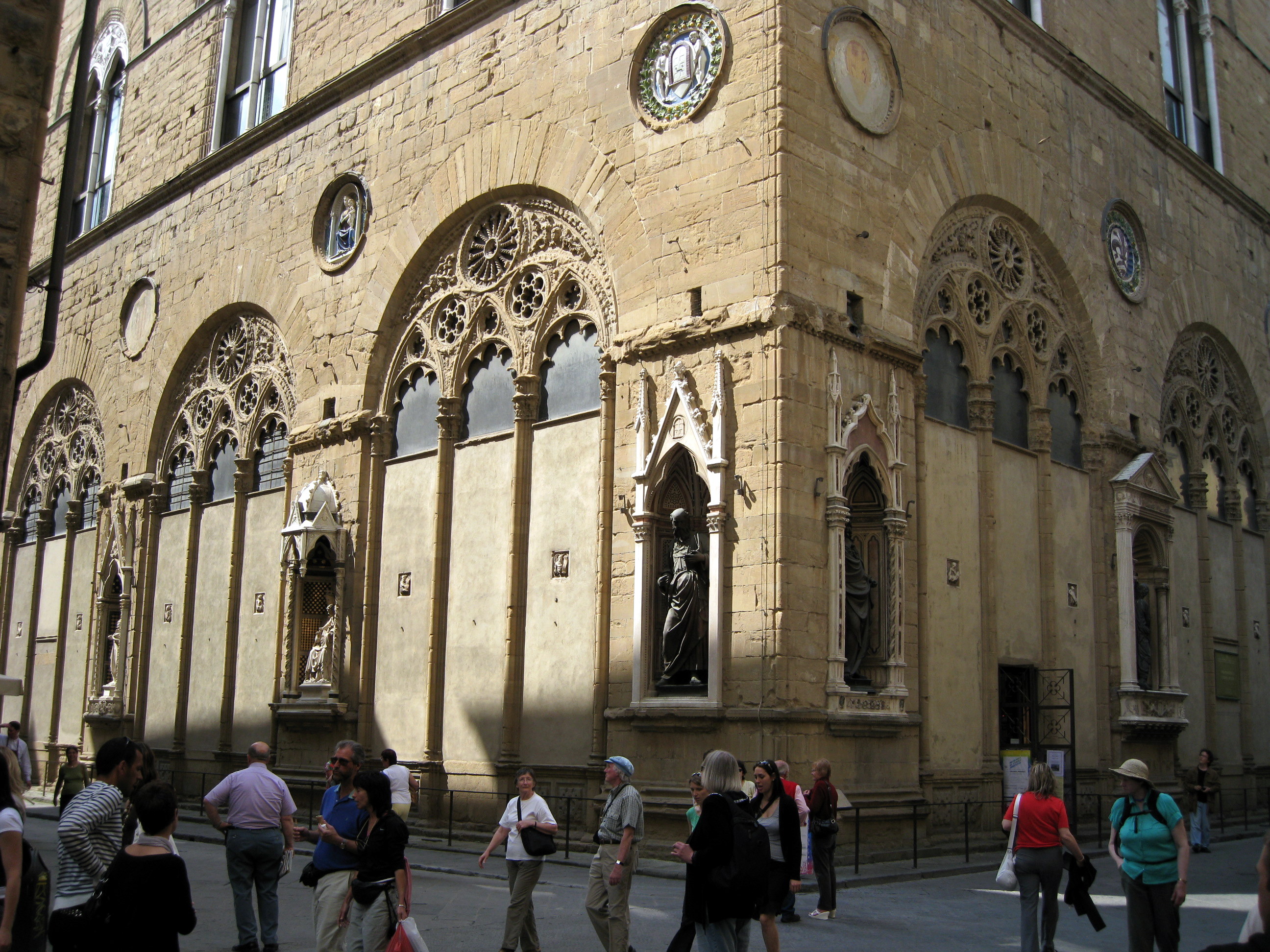 RCH
OF ORSANMICHELE. The
small orator RCH
OF ORSANMICHELE. The
small orator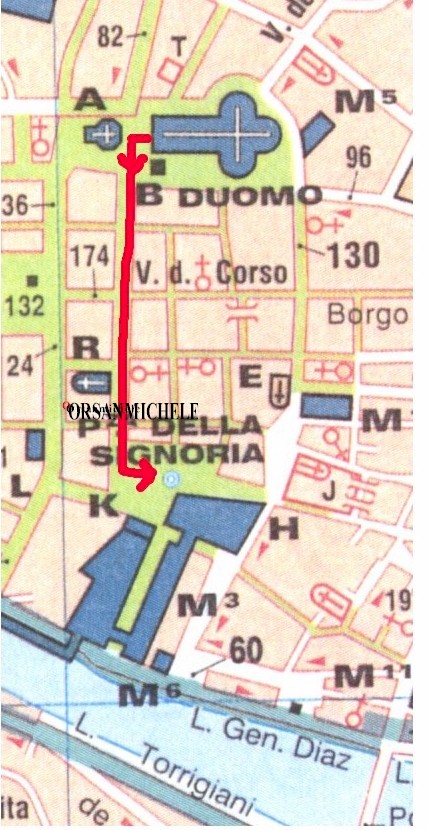 y
of Orsanmichele was located in the middle of a vegetable garden as
early as the 9th century. The
original building was replaced by a covered grain market in the 13th century. The
multi-story building which stands today was erected in 1337 following
a fire in 1304. The
upper stories were used for grain storage and the first floor for
religious purposes. y
of Orsanmichele was located in the middle of a vegetable garden as
early as the 9th century. The
original building was replaced by a covered grain market in the 13th century. The
multi-story building which stands today was erected in 1337 following
a fire in 1304. The
upper stories were used for grain storage and the first floor for
religious purposes.
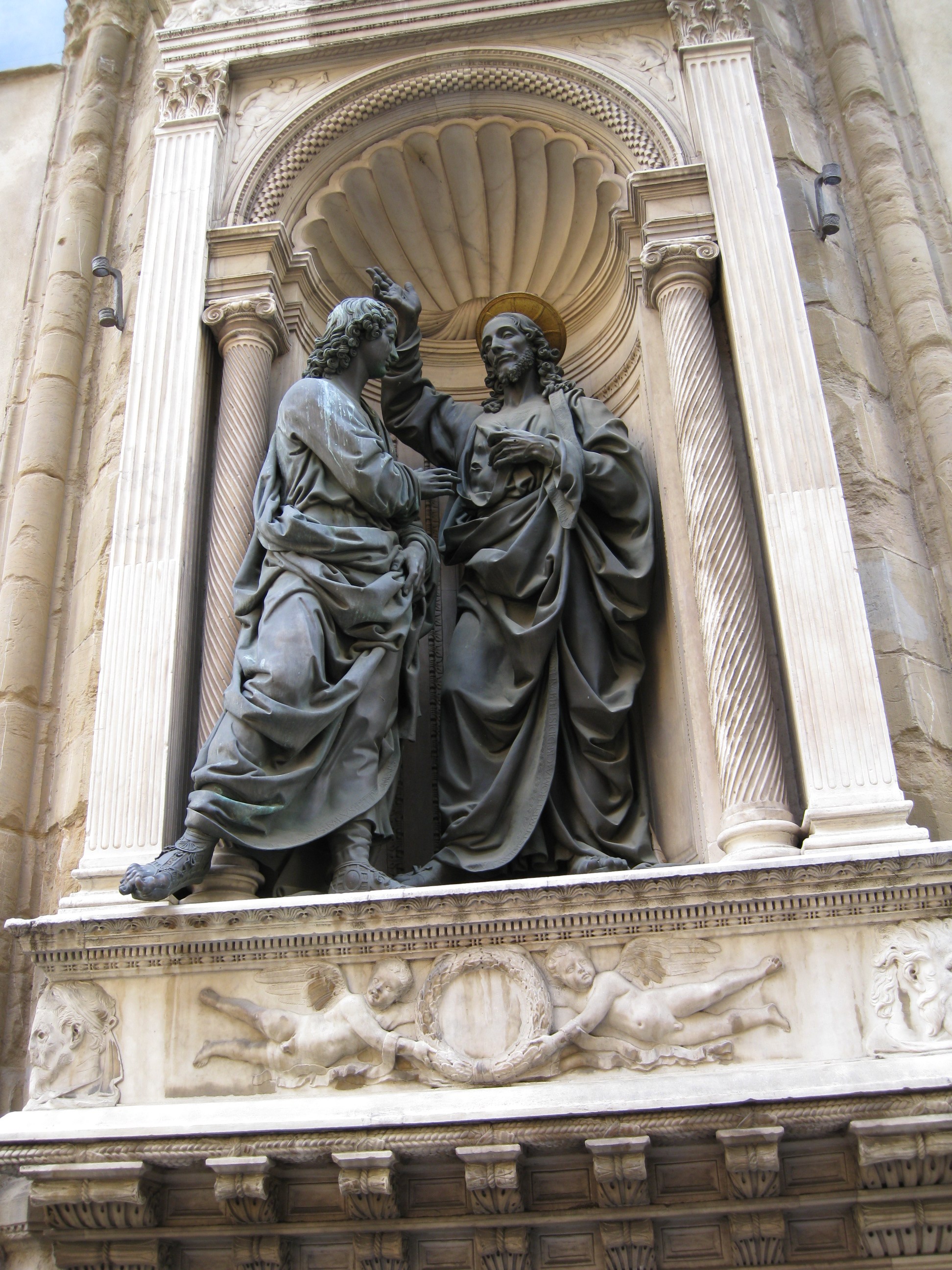
On the outside are 14 niches assigned
to the leading guilds of Florence which had the obligation of filling
them with statues of their patron saint. I
had brought a paper which identified these saints and was able to
photograph each one. I
particularly like the one of St. Thomas talking to Jesus by
Verrocchio. Thomas
has a bare foot on the ledge with a rather prominent big toe as Jesus
blesses him.
Then we went in. It
was a beautiful large room with two chapels. While
inside our phone rang, and it was Mike who said tha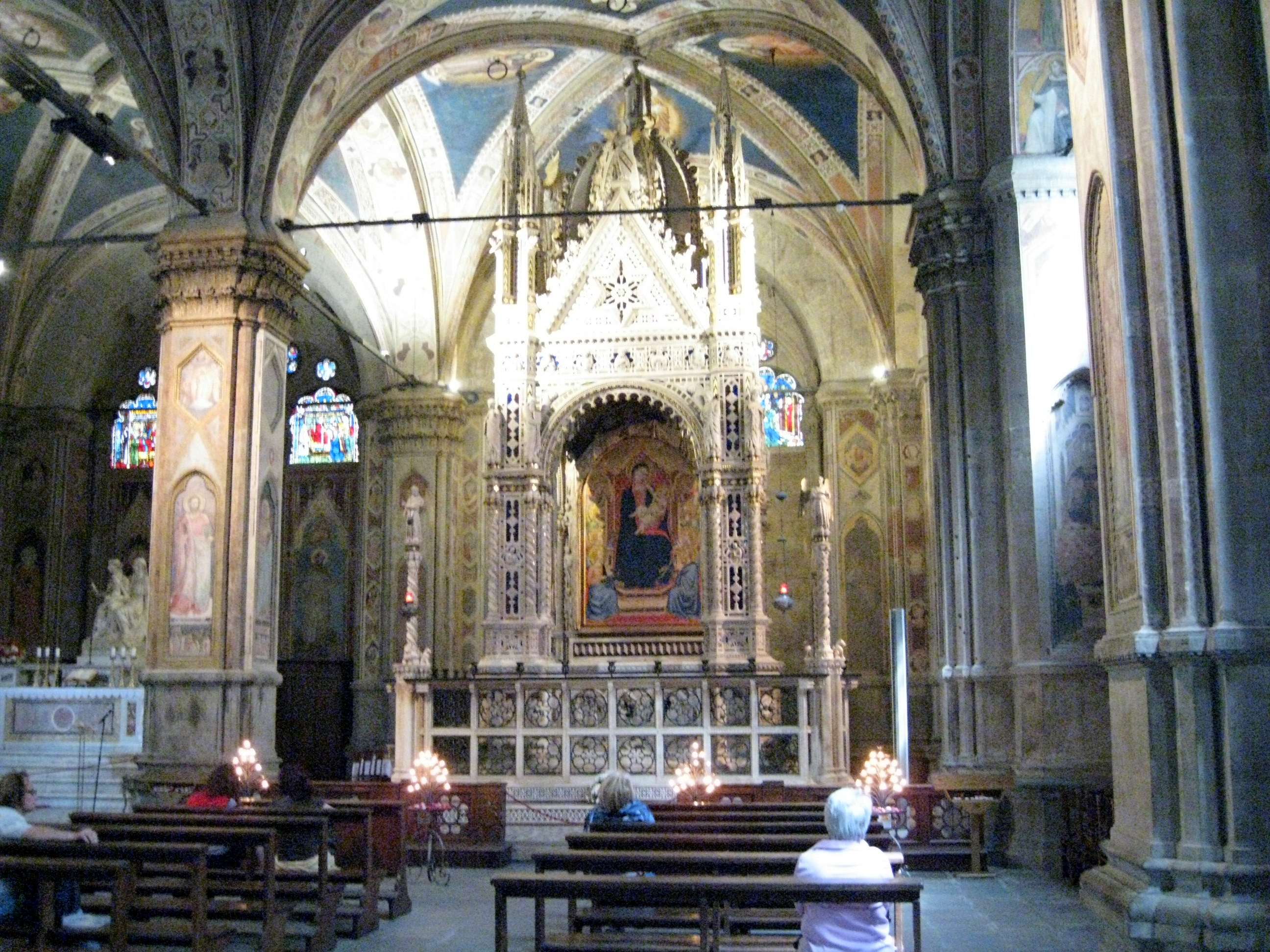 t
they had just gotten to the apartment. We
decide to go back to Fiesole later on in the afternoon, and meet them
for dinner. t
they had just gotten to the apartment. We
decide to go back to Fiesole later on in the afternoon, and meet them
for dinner.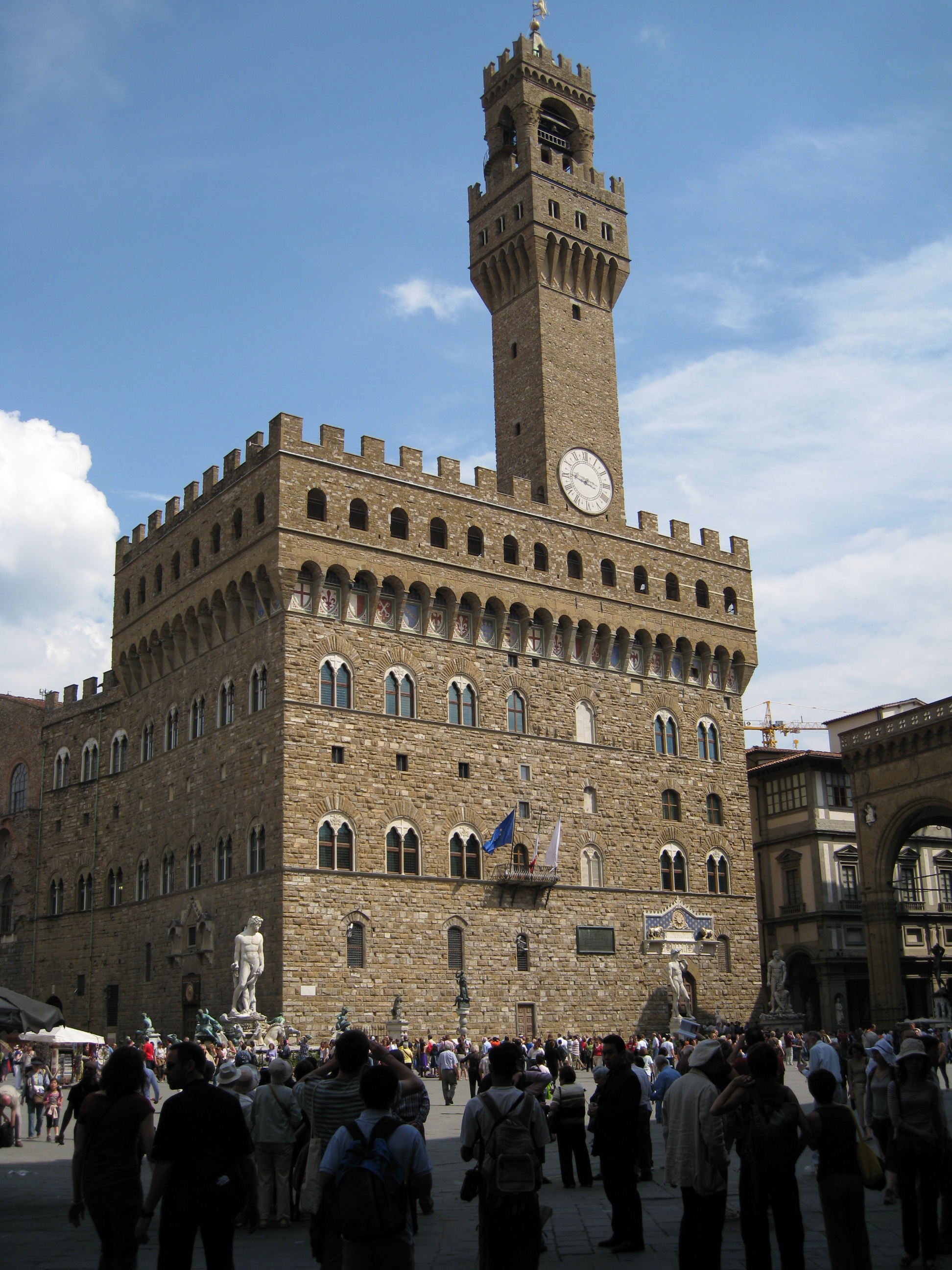
We then walked further
south to the Piazza della Signoria. We
stopped in an outdoor café. My
wife had coffee and chocolate cake. I
had perfideroles and Jack Daniel—a good combination! The
Piazza della Signoria contains the Palazzo Vecchio, and
the Loggia dei Lanzi plus a number of large outdoor statues including
a replica the Michelangelo’s David and Neptune’s fountain. The
Palazzo Vecchio is one of the most important secular buildings in
Florence. The
foundation stone was laid in 1299 and housed government offices. The
attached tower is 308 feet high.
The Loggia dei 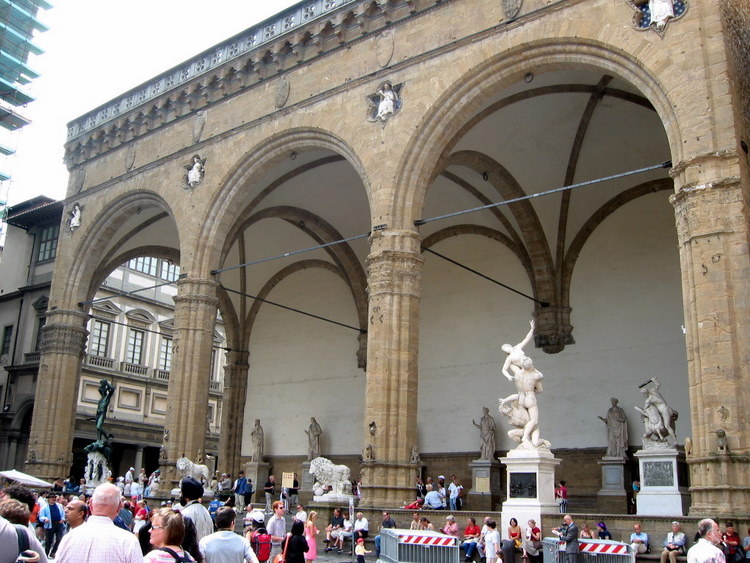 Lanzi
is an open building that contains several well known statues including
The Rape of the Sabine Women. Lanzi
is an open building that contains several well known statues including
The Rape of the Sabine Women.
We walked back to the Duomo to get a
book, but no one was behind the counter. We will go back later. We
bought a bus ticket and caught the bus back to Fiesole to meet Mike
and Mary at 6:00 pm.
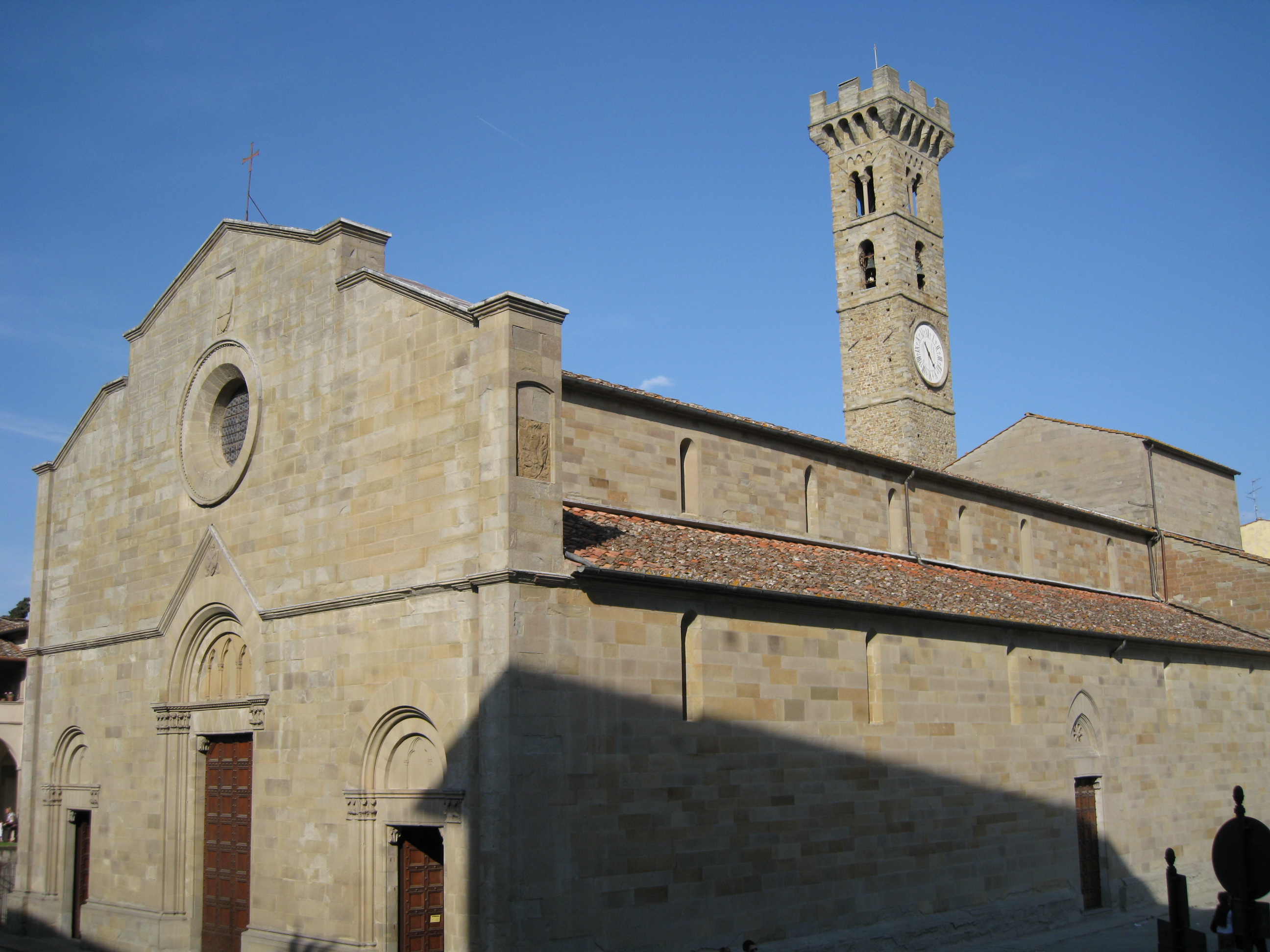 We
got back at 5:30pm and went over
to the Fiesole Duomo to take a few pictures. The
Cathedral of SAN
ROMOLO was
begun in 1028. We
got back at 5:30pm and went over
to the Fiesole Duomo to take a few pictures. The
Cathedral of SAN
ROMOLO was
begun in 1028.
The building is a ty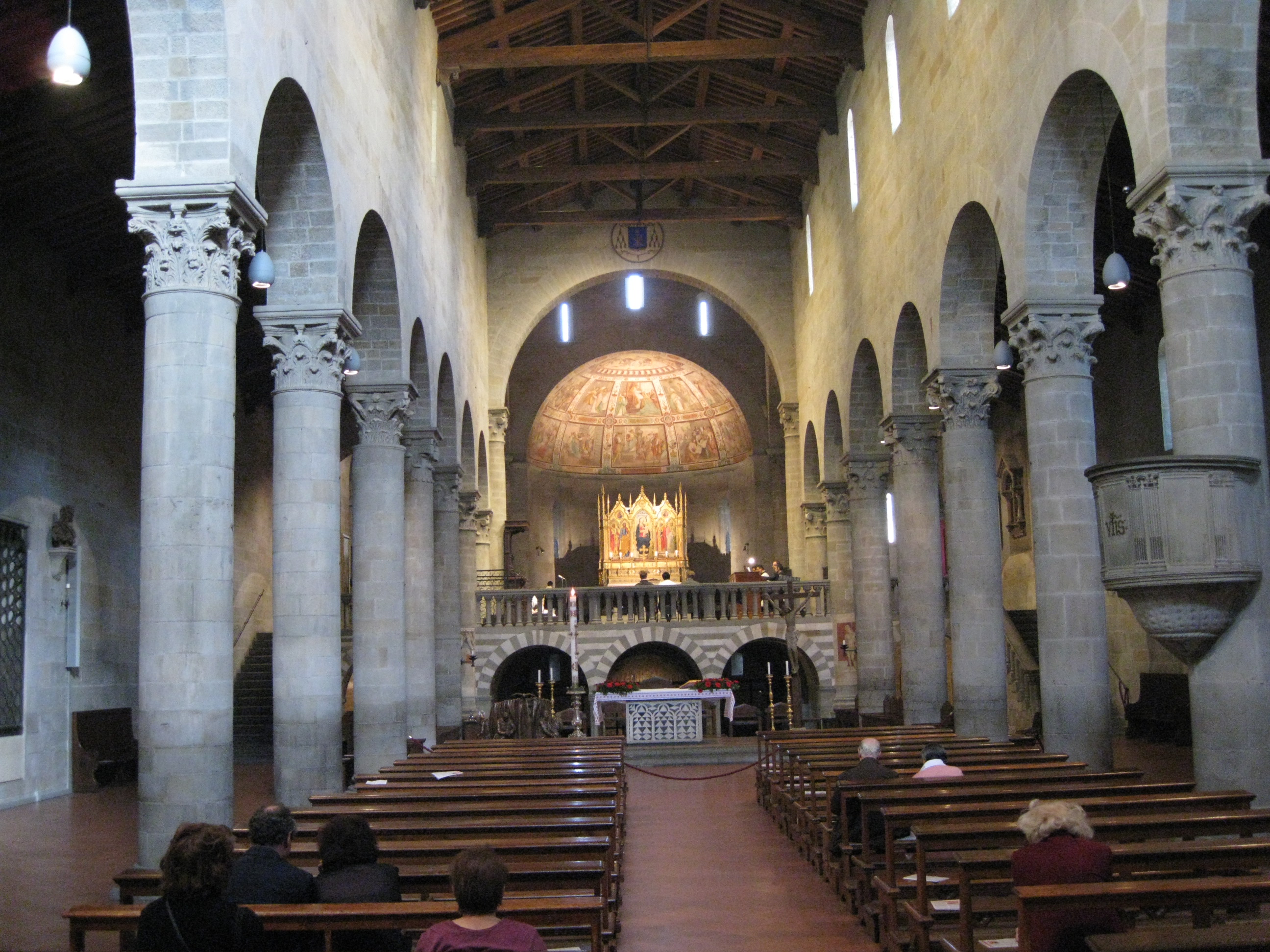 pical
basilica, with a
central nave and two aisles separated by colonnades, and though it has
been modified or restored several times over the centuries, it remains
one of the best preserved Romanesque churches in the Florentine area.
It is also one of the few that still has a crypt. As frequently occurs
in medieval buildings, the builders recycled decorative elements from
earlier structures, and took the capitals of the fourth columns from
the ruins of a Roman building. It has a very high bell tower which can
be seen from Florence. pical
basilica, with a
central nave and two aisles separated by colonnades, and though it has
been modified or restored several times over the centuries, it remains
one of the best preserved Romanesque churches in the Florentine area.
It is also one of the few that still has a crypt. As frequently occurs
in medieval buildings, the builders recycled decorative elements from
earlier structures, and took the capitals of the fourth columns from
the ruins of a Roman building. It has a very high bell tower which can
be seen from Florence.
We found Mike and Mary and went to a
café on the square for dinner. I
had scampi which were hard to eat….they still had their head and legs. My
wife had scaloppini. After dinner we stopped in a gelato shop. Nothing
like good Italian gelato!! Then back to the villa.
We talked to Paolo, the owner of the
villa and a doctor, about a dentist for my wife’s lost tooth filling
for tomorrow. He
said that there was a dentist in his office building Sieci on the
other side of the mountain. He would help us out.
This had been a wonderful day. We
have had wonderful sunny, but not hot days since we began our trip. Today
was a little overcast with some wind.
|
